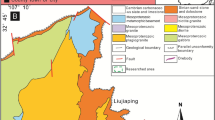Abstract
The fracture-bound deposit at the Sieringhoek (Bentheim) bitumen mine in NW Germany has yielded a substantial quantity of bitumen ore. Emplacement of the bitumen into the fracture system occurred under high pressure, causing brecciation and impregnation of the host Gildehaus Sandstone. Subsequently the bitumen was brecciated and cemented by calcite and calcite-entrained sand. Bitumen injection followed fracturing into a hydro-carbon reservoir at depth, generated from a Jurassic/Cretaceous source rock. Diagenesis of the host rock was largely completed by the time of bitumen injection, reflecting the long time gap during which source rock maturation occurred. Impurities in the bitumen include large quantities of rock fragments, abraded during injection, and crystals of metal oxides and sulphides.
Similar content being viewed by others
References
Bockshammer, H., Kurzen, F. (1934) Asphaltit Bentheim als hochwertiger Anstrich. Teer Bitumen 32:258–261
Boigk, H. (1981) Erdöl und Erdgas in der Bundesrepublik Deutschland, Enke, Stuttgart, 109 pp
Bradel, E., Hinze, C., Look, E.-R. (1988) Geologische Übersichtskarte von Niedersachen, Serie 1: 500,000, BGR/NLfB, Hannover
Curiale, J.A. (1986) Origin of solid bitumens, with emphasis on biological marker results. Org. Geochem. 10:559–580
Engler, C., Strippelmann, L. (1883) Der Bentheimer Asphalt unter Hinweisung auf analoge Vorkommen in Italien in geologischbergmännischer und chemisch-technischer Beziehung. Dinglers Polytech. J. 250:216–227
Engler, C., Strippelmann, L. (1884) Der Bentheimer Asphalt unter Hinweisung auf analoge Vorkommen in Italien in geologischbergmännischer und chemisch-technischer Beziehung. Chem. Zentralbl. 15:271–272
Jackson, D. (1985) American gilsonite: mining solid hydrocarbon. In: Picard, M.D. (ed.) Geology and energy resources, Uinta Basin of Utah. Utah Geological Association, Salt Lake City, pp. 257–261
Jacob, H. (1989) Classification, structure, genesis and practical importance of natural solid oil bitumen (“migrabitumen”). Int. J. Coal Geol. 11:65–79
Kemper, E. (1973) The Valanginian and Hauterivian stages in north-western Germany. In: Casey, R., Rawson, P.F. (eds.) The Boreal Lower Cretaceous. Geol. J. Special Issue 5:327–344
Kemper, E. (1976) Geologischer Führer durch die Grafschaft Bentheim und die angrenzenden Gebiete mit einem Abriss der emsländischen Unterkreide, 5th edn. Nordhorn, 206pp
N.A.M. (Nederlanse Aardolie Maatschappij), R.G.D. (Rijks Geologische Dienst) (1980) Stratigraphic nomenclature of the Netherlands. Verhandelingen van het Koninklijk Nederlands Geologisch Mijnbouwkundig Genootschap 32:77pp
Parnell, J. (1983) The distribution of hydrocarbon minerals in the Orcadian Basin, Scott. J. Geol. 19:205–213
Parnell, J. (1992) Metal enrichment in bitumens from Carboniferous-hosted ore deposits of the British Isles. Chem. Geol. 99:115–124
Parnell, J., Geng, A., Fu, J., Sheng, G. (1994) Geology and geochemistry of bitumen vein deposits at Ghost City, Junggar Basin, northwest China. Geol. Mag. 131:181–190
Pratsch, J.-C. (1991) Vertical hydrocarbon migration: a major exploration parameter. J. Petrol. Geol. 14:429–444
Rainer, T.F. (1926) Die Asphaltitgänge von Bentheim und ihre wirtschaftliche Bedeutung. Petroleum Zeitsk. 22:677–678
Ruhl, W. (1982a) Tar (Extra Heavy Oil) Sands and Oil Shale. Enke, Stuttgart, 149 pp
Ruhl, W. (1982b) Heavy oil occurrences in western Europe. In: Proceedings of 2nd International Conference on Heavy Crude and Tar sands, Caracas, pp. 237–256
Schott, W., Jaritz, W., Kockel, F., Sames, C.W. (1967) Zur Paläogeographie der Unterkreide im nördlichen Mitteleuropa mit Detailstudien aus Nordwestdeutschland. Bemerkungen zu einem Atlas. Erdöl Kohle 20:149–158
Strauss, C., Elstner, F., Chene, R.J. du, Mutterlose, J., Reiser, H., Brandt, K.-H. (1993) New micropalaeontological and palynological evidence on the stratigraphic position of the “German Wealden” in NW Germany. Zitteliana 20:389–401
Voigt, E. (1963) Über Randtröge vor Schollenrändern und ihre Bedeutung im Gebiet der Mitteleuropäischen Senke und angrenzender Gebiete. Z.dt. Geol. Ges. 114:378–418
Waples, D.W. (1980) Time and temperature in petroleum formation-application of Lopatin's method to petroleum exploration. Am. Assoc. Petrol. Geol. Bull. 64:916–926
Author information
Authors and Affiliations
Rights and permissions
About this article
Cite this article
Parnell, J., Ruffell, A.H., Monson, B. et al. Petrography and origin of deposits at the Bentheim bitumen mine, north western Germany. Mineral. Deposita 31, 104–112 (1996). https://doi.org/10.1007/BF00225401
Received:
Accepted:
Issue Date:
DOI: https://doi.org/10.1007/BF00225401




